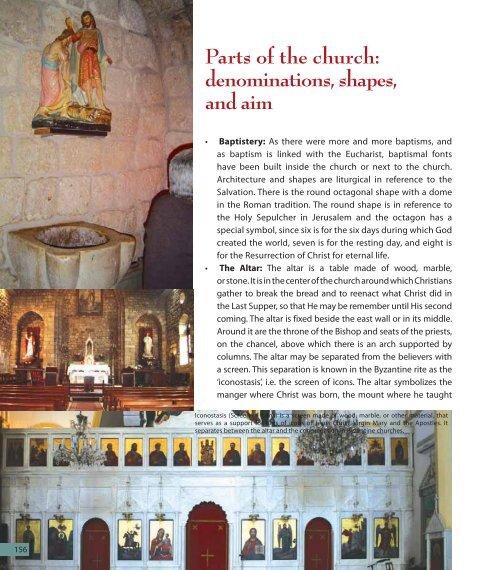Cultural aspects in Christian and Islamic religions - unesdoc - Unesco
Cultural aspects in Christian and Islamic religions - unesdoc - Unesco
Cultural aspects in Christian and Islamic religions - unesdoc - Unesco
You also want an ePaper? Increase the reach of your titles
YUMPU automatically turns print PDFs into web optimized ePapers that Google loves.
156<br />
Parts of the church:<br />
denom<strong>in</strong>ations, shapes,<br />
<strong>and</strong> aim<br />
Baptistery: As there were more <strong>and</strong> more baptisms, <strong>and</strong><br />
as baptism is l<strong>in</strong>ked with the Eucharist, baptismal fonts<br />
have been built <strong>in</strong>side the church or next to the church.<br />
Architecture <strong>and</strong> shapes are liturgical <strong>in</strong> reference to the<br />
Salvation. There is the round octagonal shape with a dome<br />
<strong>in</strong> the Roman tradition. The round shape is <strong>in</strong> reference to<br />
the Holy Sepulcher <strong>in</strong> Jerusalem <strong>and</strong> the octagon has a<br />
special symbol, s<strong>in</strong>ce six is for the six days dur<strong>in</strong>g which God<br />
created the world, seven is for the rest<strong>in</strong>g day, <strong>and</strong> eight is<br />
for the Resurrection of Christ for eternal life.<br />
The Altar: The altar is a table made of wood, marble,<br />
or stone. It is <strong>in</strong> the center of the church around which <strong>Christian</strong>s<br />
gather to break the bread <strong>and</strong> to reenact what Christ did <strong>in</strong><br />
the Last Supper, so that He may be remember until His second<br />
com<strong>in</strong>g. The altar is fixed beside the east wall or <strong>in</strong> its middle.<br />
Around it are the throne of the Bishop <strong>and</strong> seats of the priests,<br />
on the chancel, above which there is an arch supported by<br />
columns. The altar may be separated from the believers with<br />
a screen. This separation is known <strong>in</strong> the Byzant<strong>in</strong>e rite as the<br />
‘iconostasis’, i.e. the screen of icons. The altar symbolizes the<br />
manger where Christ was born, the mount where he taught<br />
Iconostasis (Screen of Icons) is a screen made of wood, marble, or other material, that<br />
serves as a support for tiers of icons of Jesus Christ, Virg<strong>in</strong> Mary <strong>and</strong> the Apostles. It<br />
separates between the altar <strong>and</strong> the congregation <strong>in</strong> Byzant<strong>in</strong>e churches.

















